The countries with the highest density of industrial robots
Tomorrow the Japanese government will open the World Robotic Summit at Koto Ward in Tokyo. Cutting-edge robots from around the world will be featured at the five-day event with a prize of JPY 100 million ($875,000).
The rise of machines has developed successfully. Data from the International Federation of Robotics shows that the pace of automation is accelerating across much of the industrialized world, with 66 industrial robots installed per 10,000 employees worldwide in 2015. A year later it rose to 74. Europe has a robot density of 99 units per 10,000 workers, and in America and Asia this figure is 84 and 63, respectively. China is one of the countries with the highest growth rates in industrial automation, but nowhere is there there is a robot density like in South Korea.
In 2016, South Korea had 631 industrial robots installed per 10,000 employees. This is primarily due to the continued installation of large-scale robots in electronics and manufacturing. 90 percent of Singapore's industrial robots are installed in the electronics industry, and with a density of 488 per 10,000 employees, Singapore ranks second. Germany and Japan are known for their automobile industries and have a density of around 300 per 10,000 employees. Interestingly, Japan is one of the major players in industrial robotics, accounting for 52 percent of the global supply.
In the United States, the pace of automation is slower, with a density of 189. China is committed to expanding its level of automation in the coming years and is targeting a place in the top 10 countries in the world for robot density by 2020. It had a density of 25 units in 2013 and grew to 68 units by 2016. India still lags behind other countries in automation, having only three industrial robots per 10,000 employees in 2016.
The Countries With The Highest Density Of Robot Workers
Tomorrow, the Japanese government is going to host the World Robotic Summit in Tokyo's Koto Ward. Cutting-edge robots from all over the world will be shown off at the five-day event with a prize of JPY 100 million ($875,000) on offer.
The rise of the machines has well and truly begun. Data from the International Federation of Robotics reveals that the pace of industrial automation is accelerating across much of the developed world with 66 installed industrial robots per 10,000 employees globally in 2015. A year later, that increased to 74. Europe has a robot density of 99 units per 10,000 workers and that number is 84 and 63 in the Americas and Asia respectively. China is one of the countries recording the highest growth levels in industrial automation but nowhere has a robot density like South Korea.
In 2016, South Korea had 631 installed industrial robots per 10,000 employees. This is mainly due to the continued installation of high volume robots in the electronics and manufacturing sectors. 90 percent of Singapore's industrial robots are installed in its electronics industry and it comes second with a density of 488 per 10,000 employees. Germany and Japan are renowned for their automotive industries and they have density levels of just over 300 per 10,000 workers. Interestingly, Japan is one of the main players in industrial robotics, accounting for 52 percent of global supply.
In the United States, the pace of automation is slower with a density rate of 189. China is eager to expand its level of automation in the coming years, targeting a place in the world's top-10 nations for robot density by 2020. It had a density rate of 25 units in 2013 and that grew to 68 by 2016. India is still lagging behind other countries in automation and it has only three industrial robots per 10,000 workers in 2016.
You will find more infographics at Statista


